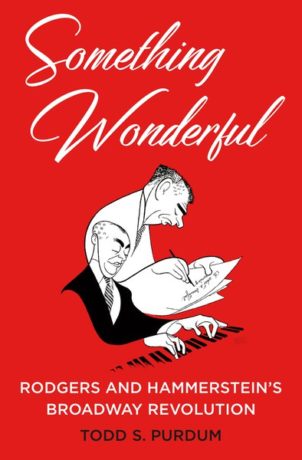How do you solve a problem like translating music into words? How do you hold a moonbeam in your hand?
Music is a gossamer thing, difficult to pin down with language. As the critic Winthrop Sargeant once wrote of composer Richard Rodgers, “any attempt to reduce his style to a formula is doomed.”

And yet in a new book about the creative partnership between Rodgers and Oscar Hammerstein II (Something Wonderful: Rodgers and Hammerstein’s Broadway Revolution), Todd S. Purdum manages to do just that, revealing the secrets of the composer’s magic tricks.
The effect is to make the reader wiser but no less spellbound.
Purdum is a lifelong fan of musical theater, and that passion shows in 400 pages that fly by in double-time. But Purdum is also smart enough to know what he doesn’t know. That’s where his considerable journalism chops come in handy. A longtime reporter for The New York Times and Politico, Purdum ushers in music directors, critics, and Rodgers and Hammerstein’s own words to create some of the book’s most illuminating passages.
In the best of these, Purdum explains how Richard Rodgers exploited the way in which the Western ear hears music. “We’ll have Manhattan,” is a case in point, he argues, with the syllable “hat” lingering in a way that sweeps the listener along. “There’s a sigh in the music that’s emotional,” explains Bruce Pomahac, director of music for the Rodgers and Hammerstein organization. Oscillating between tension and release, between “ti” and “do,” Rodgers “is having sex with you, and you’re not aware of what he’s doing. It just feels really good.”
Indeed, Rodgers, we learn, was a life-loving sensualist who shot from the hip. Fond of drink, parties, and women, he was the Dionysian counterpart to the reserved and careful Hammerstein.
Forget the Al Hirschfeld caricature of the lanky lyricist standing over the composer’s piano. Rodgers and Hammerstein preferred to work in different rooms, or better yet, different states.
Rodgers was drawn by the siren call of Hollywood. Hammerstein wrote in a bucolic Bucks County, Pa. farmhouse where a precocious youth named Steve Sondheim was his neighbor, chess partner, protégé and surrogate son. (More about “Steve” later.)
Whereas Rodgers composed so effortlessly that it was said he “peed melody,” Hammerstein could labor a fortnight over a single phrase. In a painstaking effort that took three weeks, he wrote the first words that his partner Rodgers would set to music:
There’s a bright, golden haze on the meadow.
There’s a bright, golden haze on the meadow.
The corn is as high as an elephant’s eye
An’ it looks like it’s climbin’ clear up to the sky.
Oh, what a beautiful morning’,
Oh, what a beautiful day.
I got a beautiful feelin’
Ev’erythin’s goin’ my way.”
Hammerstein correctly predicted that for many years to come, school children and summer campers would start their days singing these very words.
Purdum has a gift for scene painting, making us feel like we’re in the room when some of the most memorable moments in musical theater history take place.
There are too many to mention here, but these include a live televised performance of Cinderella featuring a young Julie Andrews; a Metropolitan Opera soprano singing “You’ll Never Walk Alone” for the first time in Richard Rodgers’s office; and a teenage Stephen Sondheim staining Dorothy Hammerstein’s fur stole with his tears at the opening night of Carousel, the story of marital discord and regret evidently hitting close to home.
I’m honestly surprised that Something Wonderful is such a pleasure to read. Given Mr. Purdum’s political résumé, I was half expecting some sort of New Historicist reading of the Rodgers and Hammerstein songbook. I predicted Purdum would find plots in every pianissimo, manifestos in every musical, but his political observations here are astute and arise out of the material itself.
When Purdum discusses the political subtext of a Rodgers and Hammerstein musical (interracial romance in South Pacific, domestic violence in Carousel), it’s never a stretch. And he’s right in concluding that Rodgers and Hammerstein were revolutionaries, casting aside Broadway’s slapstick antics and paper-thin plots to create something new–the intimate modern musical.
In doing so, they forged a link in a chain that stretches from Jerome Kern to Rodgers and Hammerstein to Sondheim, from Showboat to South Pacific to Sweeney Todd.
Overall, there is far more of Playbill than Politico in this book. It’s an even better musical theater book than Andrew Lloyd Webber’s new memoir, Unmasked, which I recently reviewed for this site, in the sense that music, not money, is its animating force.
Something Wonderful is a book about the art of making art, about how two very different men, bit by bit, link by link, drink by drink, assembled the soundtrack of the 20th century.
And it’s truly something wonderful.





